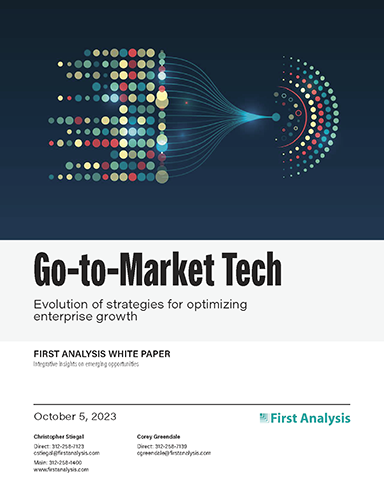White paper: Go-to-market Tech
Evolution of strategies for optimizing enterprise growth

Organizations have had to adopt and invest in new GTM strategies
With the world’s rapid digital transformation since the 1990s, human social behaviors have forever changed, and as a result, business-to-business (B2B) buyer purchase patterns have shifted toward more digital-friendly, buyer- and peer-led multi-stakeholder processes. This shift has forced many sellers to meet buyers on buyers’ terms and establish new go-to-market (GTM) strategies. Gartner defines go-to-market strategies as plans that detail how organizations can engage with customers to convince them to buy their products and services and to gain a competitive advantage. Since repeatable, consistent growth remains the No. 1 focus for executives, B2B sellers have invested significant capital to build out their GTM strategies to address the changing needs of buyers.
Complexity and resource constraints are reshaping GTM strategies
Implementing successful end-to-end GTM strategies, from customer leads to customer renewals, has never been more important for B2B sellers than it is today. We have entered an era of capital-efficient growth in which companies are rewarded not only for growing consistently but also for growing using fewer resources. This capital constraint magnifies the pressure for B2B sellers to retain existing customers and to recruit, train and retain highly productive GTM talent in an already-tight hiring environment. Further, with large investments in innovation, GTM teams’ people, processes and technologies have increasingly become disconnected, presenting additional challenges to capital-efficient growth. In response to these challenges, GTM strategies have evolved to focus on the full customer journey, from new customer acquisition to customer renewal and beyond.
The changes are driving the need for technology that enables GTM strategies
The imperative for sellers to differentiate from competitors, to scale efficiently, and to adapt to buyers’ changing needs is driving strong demand for technology and technology-enabled services that can streamline GTM strategies and connect GTM teams to their customers. As a result, new technologies, new processes, and new roles have rapidly emerged. Thousands of companies across 54 categories have developed and brought to market enabling technologies and services. These providers range widely in size. Some focus on selected industry verticals, and others design their offerings without targeting specific verticals. Similarly, some focus on one or a small subset of GTM strategies, and others work across many strategies. Together, we estimate they comprise a $125 billion market today.
TABLE OF CONTENTS
- Organizations have had to adopt and invest in new GTM strategies
- Complexity and resource constraints are reshaping GTM strategies
- The changes are driving the need for technology that enables GTM strategies
- A deeper dive: three specific growth drivers for GTM technologies
- GTM technologies address these three needs with clear returns on investment
- Market structure and competitive dynamics
- First Analysis B2B GTM technology framework
- Interconnectedness of GTM technologies
- A taxonomy of GTM strategies

Request full report
To access the full report, please provide your contact information in the form below. Thank you for your interest in First Analysis research.
